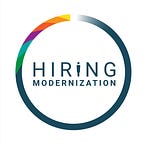First post on the Hiring Modernization Project!
This piece was published internally on September 29th, 2017
As we wrap up the second week of participatory design workshops for the Hiring Modernization Project, we wanted to take sometime to re-cap what we’ve done, learnt, and are excited about.
First, some background:
Whether you are trying to build out your own team, or are searching for your next opportunity, the hiring process affects us all. We also know that hiring is an extremely lengthy and complex process that involves many individuals and systems, especially for government roles. Improving the way we hire will have the biggest impact on how the city of San Francisco operates and the Hiring Modernization Project has been designed to ensure collaboration across the city.
This is a really unique and exciting opportunity that we are thrilled to be a part of. The collaboration will ensure that changes to the way we hire result in fair, effective and modern processes for applicants, hiring managers, human resources professionals, and others. And throughout this engagement, we are staying true to merit-based hiring, user-centered design, data-driven decision making and an iterative process. We will be sharing updates and lessons learned through this blog to keep everyone informed, continue the conversation and document our progress.
Overall structure:
A significant amount of work has already been done by San Francisco’s Department of Human Resources to help situate this project in history and time. Answering complex/meta questions such as what civil service rules govern the hiring process today? And how much time is spent waiting when hiring?
We’ll be sure to give an overview of this history later on, but for now we want to start where we joined the project.
Participatory design workshops:
David and I joined earlier this month to lead over 15 participatory design thinking workshops with HR professionals and hiring managers to unpack the hiring process and:
- Identify key bottlenecks or pain points in the process
- Identify areas of opportunity to evolve, grow, and change
This is the first phase of a three-part process, which includes:
- Experience mapping: collecting all the research we need to have really good problem definition (we are here now)
- Process refinement: ideation and prototyping (~October/November)
- Tech and procurement scoping: implementation based on what tools are available to us today and what the various key constituents need (~December/January)
Here’s what we did in 2 weeks:
- Held five 3 hour workshops with HR professionals covering the hiring process from beginning (deciding which exam to administer after doing an analysis of the job) to about a quarter of the way through (scoring of the exam and candidate list adoption). In other words, all the evaluation work that happens before the hiring manager can see the list of qualified applicants they can choose from.
- Started scheduling follow-up interviews with hiring managers
- Presented at the monthly HR professionals meeting to introduce ourselves
Here’s what we found:
(Remember these are all from the perspective of only HR professionals and only for the beginning of the hiring process)
Systems-based:
- Using multiple systems that don’t talk to each other
- Experiencing a lot of technical constraints in the current Applicant Tracking System resulting in a lot of unnecessary manual work
- Manually calculating veteran/promotive points
Process-based:
- Identifying, scheduling, and coordinating with subject matter experts and test raters
- Generally feeling under-resourced, and needing heads down time to create/evaluate tests
- Not having a centralized place to access resources/historical knowledge, and constantly having to reinvent the wheel
- Evaluating subjective minimum qualifications with no way of communicating effective internally to get a second opinion
- Being on the front-lines dealing with unhappy people who have not met the minimum qualifications for a role
Rules-based:
- Changing job specs results in a lot of back-and-forth with Subject Matter Experts and Unions
- Going through any appeals process
- Inconsistencies in promotional points
What’s next?
We’re continuing to push through with workshops since we’ve only hit one user group and a small portion of the entire hiring process. And we’ll be focusing more and more on ideating and developing solutions to prototype. If you’re interested in participating, please feel free to sign up for a workshop here, or email me if you want to chat/get involved in any way! monique.baena-tan@sfgov.org
We’ll have more to share next week!
- David and Monique
Monique Baena-Tan is Researcher and Service Designer for the Hiring Modernization Project. Most recently Monique led design research on Code for America’s talent initiative which included a job board to help technologists find opportunities in public interest tech, and documented best practices across the country in government hiring.
David Huebner is Project Manager and Strategy Advisor for the Hiring Modernization Project. He most recently worked at Code for America where he led a talent initiative focused on helping governments improve their people practices to ensure they can hire and retain technologists to deliver services most effectively. Previously, David worked at Google as a Manager on a strategy, analytics and effectiveness team focusing on hiring and people services.
